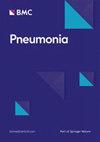Potential use of serum based quantitative real-time PCR for the detection of pneumonia pathogens in a densely colonised population
IF 8.5
Q1 RESPIRATORY SYSTEM
引用次数: 4
Abstract
Molecular methods offer improvement in the detection of causative pneumonia pathogens, but there are concerns of false positive results. Here we validate quantitative real-time PCR (qPCR) assays for the detection of Streptococcus pneumoniae and Haemophilus influenzae in: (a) spiked serum samples and (b) in matched serum and nasopharyngeal swabs from a population of Indigenous Australian children without pneumonia, but with a high nasopharyngeal carriage prevalence of S. pneumoniae and H. influenzae. Matched sera and nasopharyngeal swabs were selected from Indigenous children less than 5 years of age without a diagnosis of pneumonia. Specimens were assayed by qPCR targeting the lytA and glpQ genes from S. pneumoniae and H. influenzae, respectively. Using qPCR, neither S. pneumoniae nor H. influenzae DNA was detected in serum samples, even after concentration of serum DNA. In matched nasopharyngeal swabs, bacterial load was high with up to 106 cells/ml detected by qPCR. In this cohort of children with a high nasopharyngeal carriage, prevalence and bacterial load of pneumonia pathogens, qPCR on sera would not have produced a false pneumonia diagnosis. Thus, qPCR analysis of sera appears to be an appropriate method to aid aetiological diagnosis of pneumonia in this population.基于血清的实时荧光定量PCR在密集定植人群中检测肺炎病原体的潜在应用
分子方法为肺炎病原体的检测提供了改进,但也存在假阳性结果的担忧。在这里,我们验证了实时荧光定量PCR (qPCR)检测肺炎链球菌和流感嗜血杆菌的方法:(a)加标血清样本和(b)匹配的血清和鼻咽拭子样本,这些样本来自澳大利亚土著儿童,他们没有肺炎,但鼻咽携带肺炎链球菌和流感嗜血杆菌的比例很高。从没有肺炎诊断的5岁以下土著儿童中选择匹配的血清和鼻咽拭子。采用qPCR方法分别检测肺炎链球菌和流感嗜血杆菌lytA和glpQ基因。使用qPCR,即使在血清DNA浓缩后,也未在血清样本中检测到肺炎链球菌和流感嗜血杆菌的DNA。在匹配的鼻咽拭子中,细菌载量很高,qPCR检测到106个细胞/ml。在这组具有高鼻咽部携带率、患病率和肺炎病原体细菌负荷的儿童中,血清上的qPCR不会产生错误的肺炎诊断。因此,血清qPCR分析似乎是一种适当的方法,以帮助在这一人群肺炎的病原学诊断。
本文章由计算机程序翻译,如有差异,请以英文原文为准。
求助全文
约1分钟内获得全文
求助全文

 求助内容:
求助内容: 应助结果提醒方式:
应助结果提醒方式:


